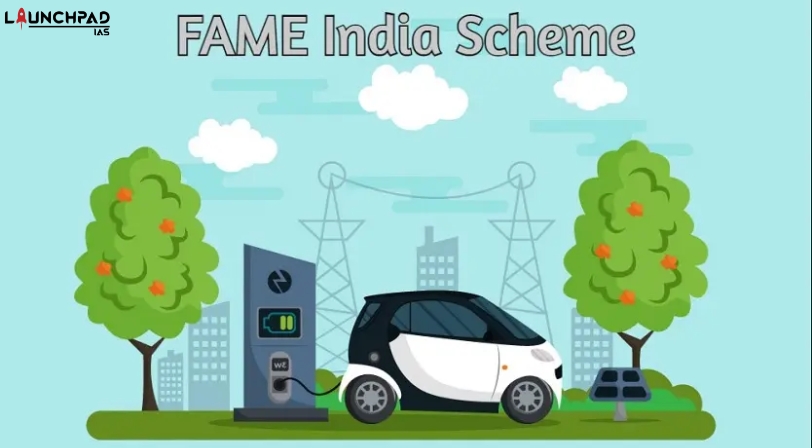- Faster Adoption and Manufacturing of (Hybrid &) Electric Vehicles in India (FAME-India) Scheme was launched under the National Mission on Electric Mobility in 2011/ National Electric Mobility Mission Plan 2020, unveiled in 2013.
- The scheme aims to encourage the progressive induction of reliable, affordable, and efficient electric vehicles and hybrid vehicles (xEV).
- The First Phase of the scheme was initially approved for 2 years, commencing in 2015.
- The Scheme has been extended from time to time, with the previous extension allowed for a period up to 2019 which has now again been extended up to 2024.
- It is under the framework of the Demand Incentive Disbursement Mechanism.
- The incentive amount has been determined for each category of vehicles like Mild Hybrid, Strong Hybrid, Plug-in Hybrid, and Pure Electric technologies and battery specification.
- It is implemented and monitored by the National Automotive Board under D/o Heavy Industry. It is one of the DBT schemes categorized under in-kind mode.
Objectives of FAME India:
The primary objectives of the Fame India scheme are listed below.
- This scheme encourages electric vehicle manufacturers and related providers to manufacture more electric vehicles in the country.
- Its goal is to reduce vehicular emissions and air pollution levels within the country.
- This scheme also aims to establish an electric charging infrastructure.
- In addition, Fame India Scheme targets to convert 30% of total transportation into electric vehicles by 2030.
Features of Fame India Scheme
Fame India Scheme operates in two phases:
- Phase I: The first phase of the FAME India Scheme started in 2015 and was functional till 31st March 2019.
- Phase II: The second phase of this scheme started in April 2019 and will continue till 31st March 2022. The Government has decided to further extend Fame India Scheme Phase II till 31st March 2024.
Phase I
The concerned authorities implemented the first phase by focusing on four key areas:
- Demand Creation
- Technology Platform
- Pilot Project
- Charging Infrastructure
The Government installed 427 charging stations during Phase I.
The Government allotted ₹ 895 crores to cover the operations of Phase I. Here, nearly 2.8 lakh electric vehicles were supported with an amount of ₹ 359 crores.
Phase II
The second phase of the Fame India Scheme stresses on electrification of public transportation and shared transportation.
This phase gets budgetary support of ₹ 10,000 crores.
Through this scheme, the concerned department aims to provide incentives to various categories of vehicles:
- Electric Two-wheelers: 10 lakh registered electric two-wheelers will get an incentive of ₹ 20,000 each.
- Electric Four-wheelers: 35,000 electric 4-wheelers with an ex-factory price of ₹ 15 lakhs will get an incentive of ₹ 1.5 lakh each.
- Hybrid Four-wheelers: Through this scheme, the Government will provide ₹ 13,000 – ₹ 20,000 as an incentive to hybrid 4-wheelers with an ex-factory price of ₹ 15 lakh.
- e-rickshaws: 5 lakh e-rickshaws (each) can avail ₹ 50,000 as incentives.
- e-buses: Nearly 8000 e-buses with a maximum ex-factory price of ₹ 2 crores will receive an incentive of ₹ 50 lakh each.
Under the second phase of the Fame India Scheme, the Government is hopeful of establishing 2700 charging stations in metros, smart cities, hilly states, and million-plus cities across the country. The grid measurement will follow a 3 km x 3 km layout.
The Government aims to cover highways as well and establish charging stations on both sides of the road with a gap of 25 km between two consecutive stations.
Advantages of FAME
The Fame India scheme offers the following benefits:
- Issues related to environmental and fuel conservation will be significantly reduced.
- Vehicles from different segments will receive subsidy benefits accordingly.
- Citizens can avail themselves of eco-friendly public transportation.
- This scheme will allow individuals to reap the benefits of renewable energy sources through charging systems.
- The establishment of charging stations nearby further encourages individuals to opt for electric vehicles.
To avail of the benefits offered under the Fame India Scheme, applicants have to first be eligible for it.
The benefits of the Fame India scheme are available for the following individuals:
- Electric vehicle manufactures
- Electric vehicle infrastructure providers
Concerns regarding FAME
Without assuring there is enough demand for the electric and hybrid vehicles produced, it aims to hasten manufacture in India.
Additionally, electric two- and three-wheelers are best suited to Indian road conditions.
- Electric scooter ride-sharing has become widely accepted as being incredibly convenient in many Western cities.
- Small electric scooters have the potential to revolutionize urban transportation in India in this regard.
- But FAME effectively discourages the use of smaller automobiles.
- This is so that the incentive’s value can be correlated with the size of the car’s battery.
Approximately 95% of the electric two-wheeler models now made in India won’t receive incentives under FAME-II.


